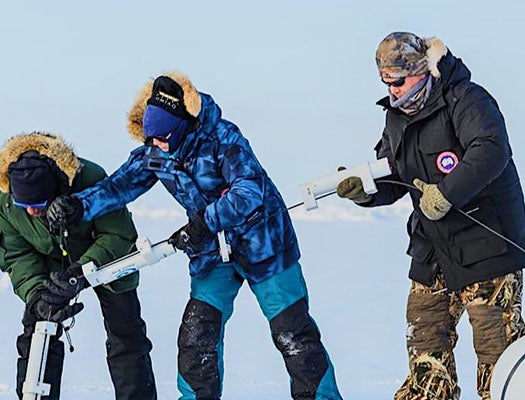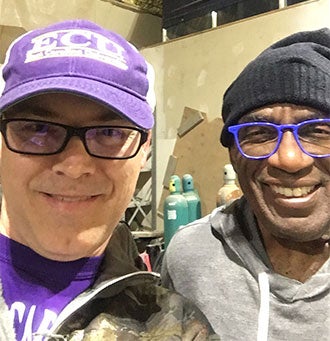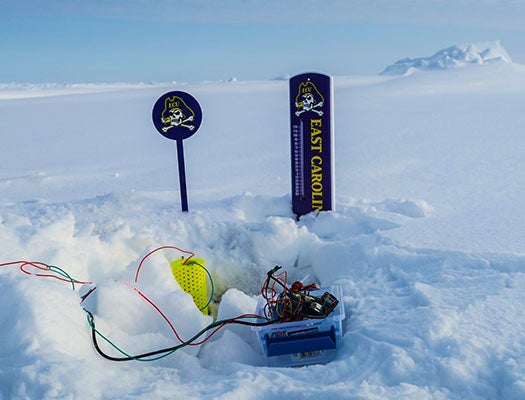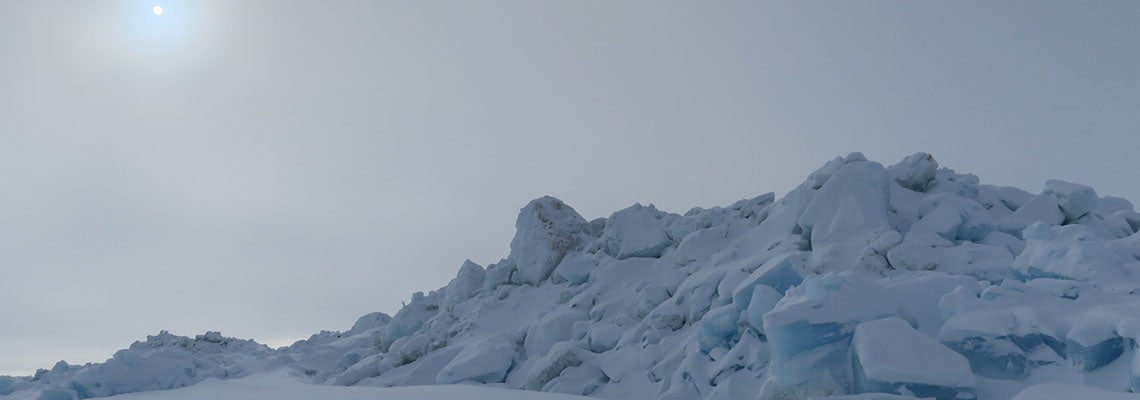SUCCESS IN THE ARCTIC
Sensor developed by ECU students proves to be a success
Changes seen in the Arctic climate have a direct impact on the frequency and intensity of hurricanes experienced in eastern North Carolina.
That is why Dan Dickerson, an East Carolina University science education professor and STEM CoRE coordinator, recently traveled to Utqiagvik – the northernmost city in Alaska – to help researchers collect data and test the Smart Stick, a snow sensor prototype developed by engineering students at ECU.
Dickerson traveled to the Arctic March 30 through April 6 with a small team of researchers from other universities and agencies. They braved temperatures as low as -15 degrees Fahrenheit to deploy multiple types of data collection sensors that are used to measure everything from melting snow to the conditions in the atmosphere in an effort to better understand the changing climate.
He said the most rewarding part of the trip to the Arctic was when the snow sensor’s little light came on and data started rolling in after it was deployed. Engineering students who work with Dr. Zhen Zhu in the College of Engineering and Technology took the idea Dickerson had for a sensor and made it into a product.

Dickerson, far right, helps Al Roker, left, lower a buoy into the ice with Victoria Hill of Old Dominion University. (Contributed photo)
The Smart Stick sensor they created measures melting snow to help with climate change research. It measures melt on top of and under the snow. The data it collects will be combined with information from other types of sensors to give a more complete picture of how quickly snow and ice is breaking apart and where the current moves.
“Seeing something ECU students designed work — that was awesome,” said Dickerson.
To create the prototype, he and the student engineering team depended on information from people who had been in the cold conditions before since they had never traveled to the Arctic. The trip allowed Dickerson to see how well the design worked under extreme conditions and what could be improved.
Now that Dickerson has seen firsthand what the conditions are like, they can make a new design that is better suited for the environment. Some of the changes they will take into consideration include making it easier to adjust the sensor with thick gloves on and deterring bears that might mistake the sensor for a toy.
“What we want to do is to make something that is cheaper and easier to deploy and provide robust data more so than anything else out on the market. So there are some changes that we need to make but I think they are doable,” said Dickerson.

Dickerson snags a selfie with the “Today” show’s Al Roker while in Alaska. (Photo by Dan Dickerson)
“TODAY” show in the Arctic
In addition to the unique trip to the Arctic, Dickerson’s research team had a brush with fame. NBC’s “TODAY” morning news show joined the group to capture some of their work. Well-known television meteorologist Al Roker interviewed members of the team for live segments dealing with climate change and how it is affecting residents of the northernmost city in the United States.
“To watch them set up for a live shot in a place where I couldn’t even get cell service was insane,” said Dickerson. He said the team from the “TODAY” show was professional and that Roker was very nice and interesting to work with.
The “TODAY” show broadcast live for three mornings in Utqiagvik and spent the rest of the time recording segments. Though Dickerson wasn’t interviewed, he did appear in many of the shots and had a once-in-a-lifetime experience.

A Smart Stick snow sensor prototype developed by ECU engineering students is deployed in the Arctic. (Photo by Dan Dickerson)
The research team Dickerson traveled with included members from Old Dominion University, University of Washington, and National Oceanic and Atmospheric Administration.
“Our researchers impact the future of science not just in Greenville, but around the world. Taking our research out of the lab and testing it in regions like the Arctic alongside respected, national institutions shows the large-scale impact we can make,” said Dr. Jay Golden, vice chancellor for research, economic development and engagement at ECU. “We’re going to continue to push our faculty to explore trips like Dan’s so that their hard work and innovation is recognized and appreciated at the local, national and international levels.”
For Dickerson, the trip as a whole helped the country see how seriously ECU takes research and how we apply that regionally and globally.
Dickerson hopes to go on another trip to an area where he can deploy the updated version of the sensors. In the meantime, he said the success of this collaboration will lead to more work in the future in the area of climate change.
As part of ECU’s STEM CoRE, which finds unique ways to enhance learning experiences for students in kindergarten through high school, he is exploring ways to bring his experience into the classrooms of public schools.
Life in the Arctic
Research often takes professors at ECU all around the world. Though research was the main objective for Dickerson’s trip, life in the Arctic was a completely new experience for him.
“The first thing that hit me when I got off the plane was the cold. I’ve experienced cold before but nothing like that,” said Dickerson. “The temperatures there were warmer than normal, for them. I was freezing to death. The coldest it got while we were there was -15 degrees Fahrenheit and that was without factoring in wind chill.”
Traveling to the Arctic, where fishing and whaling are primary sources of income, did not include five-star accommodations or luxury rides to their research destinations. The day-to-day reality was a stay in barracks with other researchers, breakfast and then a snowmobile ride several miles outside of Utqiagvik on top of the frozen Pacific Ocean to deploy sensors.
The first day of the trip, they participated in training, including how to use a snowmobile, what to do if they encounter animals like bears and foxes, and the importance of paying attention to the quickly changing weather conditions.
Deploying sensors meant drilling through ice and using sleds on the back of snowmobiles to move their equipment around. They had to travel with bear guards who took the lead in case they walked into a bear’s territory. Fortunately, Dickerson’s team did not personally encounter bears. Unfortunately, one of his colleague’s sensors was destroyed by a curious bear after it was deployed.
“It was very desolate. The wind up there is pretty stiff because there are no trees, anywhere. So I saw no trees and no animals. I saw three birds and two dogs the entire time, which is really strange coming from eastern North Carolina,” he said.
The information collected from ECU’s Smart Stick and the other sensors placed in the Arctic will help scientists with weather forecasting and modeling which is important for the people of Alaska and the rest of the world.
Related story: Arctic Adventure

(Photo by Dan Dickerson)
